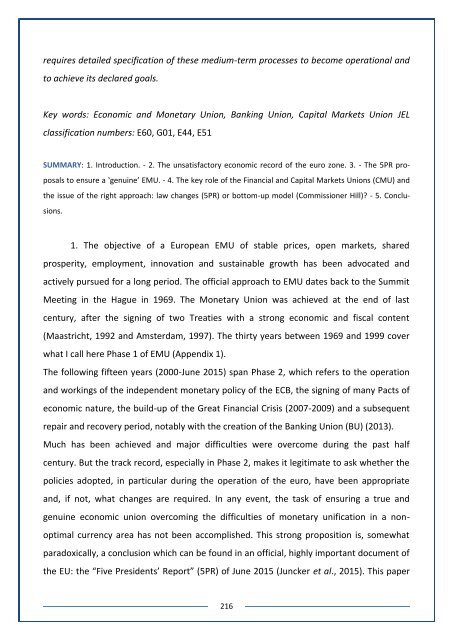ECONOMICS YEARLY REVIEW
Law_and_Economics_Yearly_Review_LEYR_Journal_vol_4_part_2_2015
Law_and_Economics_Yearly_Review_LEYR_Journal_vol_4_part_2_2015
You also want an ePaper? Increase the reach of your titles
YUMPU automatically turns print PDFs into web optimized ePapers that Google loves.
equires detailed specification of these medium-term processes to become operational and<br />
to achieve its declared goals.<br />
Key words: Economic and Monetary Union, Banking Union, Capital Markets Union JEL<br />
classification numbers: E60, G01, E44, E51<br />
SUMMARY: 1. Introduction. - 2. The unsatisfactory economic record of the euro zone. 3. - The 5PR proposals<br />
to ensure a ‛genuine’ EMU. - 4. The key role of the Financial and Capital Markets Unions (CMU) and<br />
the issue of the right approach: law changes (5PR) or bottom-up model (Commissioner Hill)? - 5. Conclusions.<br />
1. The objective of a European EMU of stable prices, open markets, shared<br />
prosperity, employment, innovation and sustainable growth has been advocated and<br />
actively pursued for a long period. The official approach to EMU dates back to the Summit<br />
Meeting in the Hague in 1969. The Monetary Union was achieved at the end of last<br />
century, after the signing of two Treaties with a strong economic and fiscal content<br />
(Maastricht, 1992 and Amsterdam, 1997). The thirty years between 1969 and 1999 cover<br />
what I call here Phase 1 of EMU (Appendix 1).<br />
The following fifteen years (2000-June 2015) span Phase 2, which refers to the operation<br />
and workings of the independent monetary policy of the ECB, the signing of many Pacts of<br />
economic nature, the build-up of the Great Financial Crisis (2007-2009) and a subsequent<br />
repair and recovery period, notably with the creation of the Banking Union (BU) (2013).<br />
Much has been achieved and major difficulties were overcome during the past half<br />
century. But the track record, especially in Phase 2, makes it legitimate to ask whether the<br />
policies adopted, in particular during the operation of the euro, have been appropriate<br />
and, if not, what changes are required. In any event, the task of ensuring a true and<br />
genuine economic union overcoming the difficulties of monetary unification in a nonoptimal<br />
currency area has not been accomplished. This strong proposition is, somewhat<br />
paradoxically, a conclusion which can be found in an official, highly important document of<br />
the EU: the “Five Presidents’ Report” (5PR) of June 2015 (Juncker et al., 2015). This paper<br />
216


